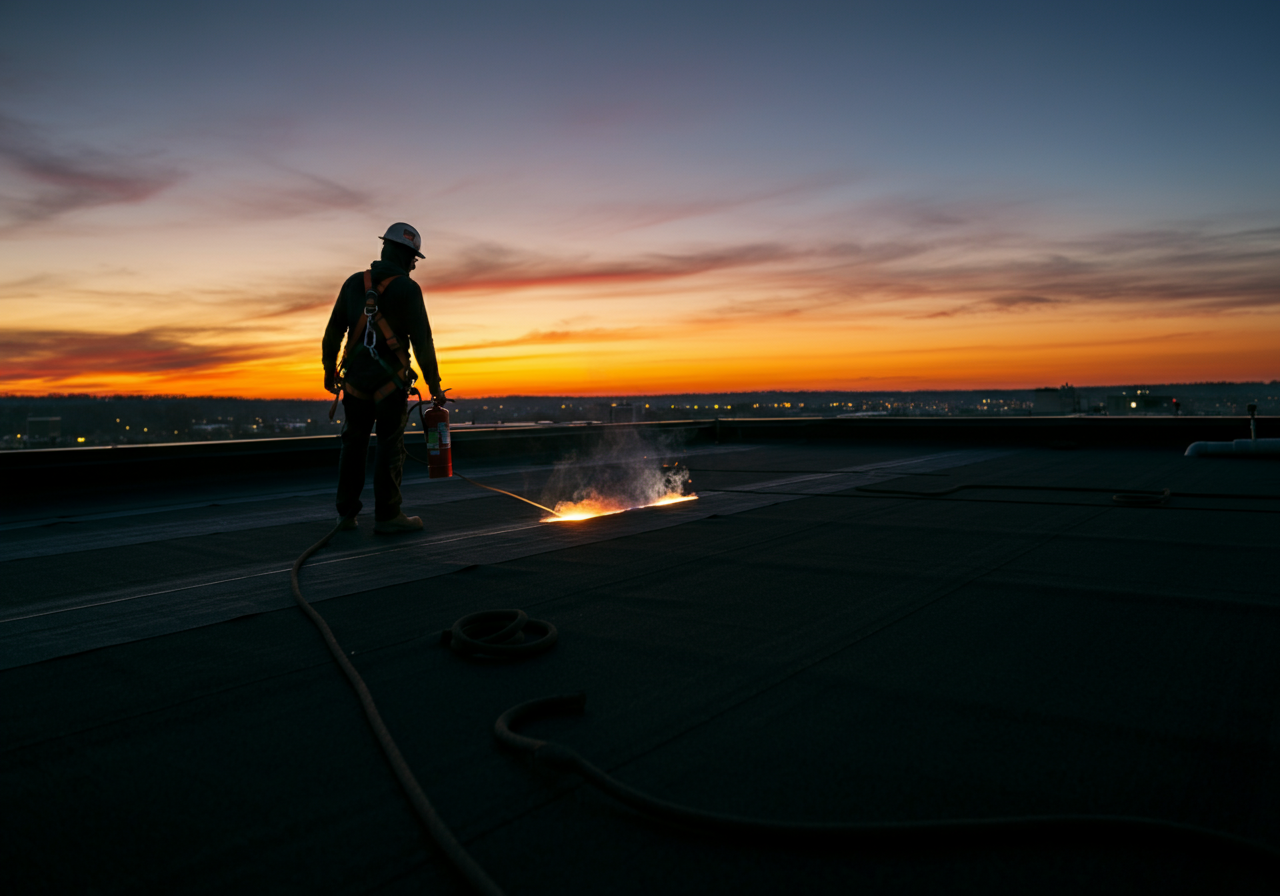
 Article
Article
 Article
Article

Roof heat welding is a common practice in commercial roofing, offering numerous benefits such as waterproof seals and wind resistance. However, this process, categorized as hot-work, carries inherent dangers that demand meticulous safety protocols, particularly a well-executed fire watch. This article delves into the specifics of roof heat welding, explores the benefits and dangers of hot-work, and emphasizes the critical importance of a vigilant fire watch to prevent catastrophic accidents.
Roof heat welding is a technique used to fuse together sheets of thermoplastic roofing materials, most commonly polyvinyl chloride (PVC) membranes. A specialized tool called a heat welder directs hot air onto the overlapping edges of the membranes, melting and fusing them to create a seamless, waterproof seal.
Hot-work encompasses any process that involves open flames or generates enough heat to potentially ignite combustible materials. Besides roof heat welding, other examples include soldering, grinding, and cutting.
Heat welding offers several advantages over traditional adhesive-based seam sealing methods:

While roof heat welding boasts numerous advantages, the risks associated with hot-work on roofs cannot be ignored. Scientific research and expert opinions from organizations like the Infrastructure Health and Safety Association (IHSA) underscore the critical need for robust safety measures.
Burn Injuries: The high temperatures involved in heat welding pose a significant risk of burns to roofers. Propane torches used in torch-applied roofing can reach temperatures exceeding 1093°C (2000°F), while hot bitumen, used in built-up roofing, can also cause severe burns.
Fire and Explosion Hazards: The presence of flammable materials on roofs, coupled with open flames or sparks from hot-work equipment, creates a substantial risk of fire and explosions. Propane leaks, overheating of asphalt kettles, and improper handling of hot-air welders can all lead to disastrous consequences.
Electric Shock: Electric-powered hot-air welders, commonly used in single-ply roofing, pose a risk of electric shock, especially in wet conditions or when equipment is damaged.
Heat Stress: Working on low-slope roofs exposes roofers to intense heat from the sun, further exacerbated by the heat generated during hot-work. This increases the risk of heat exhaustion or heat stroke, potentially leading to severe health complications.
Falls: Roof work, by its very nature, carries a significant risk of falls. According to the Bureau of Labor Statistics, roofers have one of the highest rates of fatal work injuries, with falls being the leading cause.
The Cost of Complacency: A chilling reminder of the potential consequences of inadequate safety measures is the statistic that 15% of all fires in commercial and industrial properties are caused by hot-work. In the United States alone, the National Fire Protection Association (NFPA) reports an average of 4,580 structure fires caused by hot-work annually, resulting in $484 million in direct property damage, 22 deaths, and 171 civilian injuries. (NFPA, Zurich Insurance)
These figures underscore the urgent need for stringent safety protocols and a proactive approach to risk management when undertaking hot-work on roofs.

A fire watch is a critical safety measure employed during and after hot-work operations to prevent and mitigate fire hazards. It involves designating a trained individual to continuously monitor the work area and surrounding areas for signs of fire, smoke, or smoldering materials.
Responsibilities of a Fire Watch:
Benefits of a Fire Watch:
Authority & Availability: Expert opinions from organizations like the National Fire Protection Association (NFPA) and insurance companies like Zurich emphasize the critical importance of a fire watch during hot-work, especially in roofing operations. The NFPA standard mandates a fire watch for at least one hour after torch-applied roofing is completed. (NFPA, Zurich Insurance)

Implementing comprehensive safety protocols is essential for a safe roof heat welding operation:
Authority & Availability: The IHSA offers comprehensive guidelines for hot-work safety in their Low-Slope Roofing Health and Safety Manual , Safe Practices for Working On or Around Photovoltaic Systems, and Propane Safety for Low-Slope Roofers brochures, providing readily available resources to ensure safe practices.

While a fire watch is an essential safety measure during and after hot-work, traditional methods relying solely on human observation have inherent limitations that can compromise its effectiveness.
The cornerstone of traditional fire watch is human vigilance. However, human beings are prone to error, distraction, and fatigue, particularly when performing monotonous tasks for extended periods. External factors, like noise, weather conditions, or personal thoughts, can divert a fire watch's attention, leading to missed signs of a fire hazard. Long hours and repetitive tasks can lead to fatigue, reducing alertness and impairing judgment, increasing the risk of overlooking a smoldering ember or a small flame. Inexperience or inadequate training can lead a fire watch to misinterpret signs of a fire hazard, delaying response and allowing a small incident to escalate.
The aftermath of a hot-work roofing project often brings a sigh of relief. The work is done, the crew is gone, and a fire watch has diligently monitored the site for the required period. But a chilling reality persists: sometimes, fires ignite hours, even days, after the fire watch has ended, turning a sense of security into a nightmare scenario.
Several factors contribute to this delayed ignition:

The standard practice of employing a fire watch for a limited period after hot-work, often paid in overtime, presents a dilemma for roofing companies:
The implications of hot-work safety extend far beyond the immediate risks faced by roofers on the job site. Both roofing companies and insurance providers have a significant stake in ensuring that proper fire watch protocols are followed and accidents are prevented.

For roofing companies, a fire caused by inadequate hot-work safety practices can have devastating consequences:
Financial Burden: Fires can result in significant financial losses, including property damage, equipment replacement, business interruption, and potential lawsuits. The NFPA reports that hot-work-related fires cause an average of $484 million in direct property damage annually in the United States alone.
Reputational Damage: A fire incident, especially one that results in significant damage or injury, can severely damage a roofing company's reputation. As highlighted in the provided source, the biggest concern for roofers is the risk of reputational damage caused by a highly publicized fire. This can lead to a loss of trust from clients, difficulty securing new projects, and a decline in business.
Increased Insurance Costs: Insurance providers are increasingly scrutinizing hot-work safety practices. A fire incident can lead to higher insurance premiums, making it more expensive for roofing companies to operate.
Operational Inefficiencies: A fire can disrupt a roofing company's operations, delaying projects, causing scheduling conflicts, and straining resources. As noted, roofers may face operational inefficiencies, including having to pay overtime for extended fire watch hours and the inability to start new projects due to manpower shortages caused by the fire.
Legal Liability: Roofing companies can be held legally liable for fires caused by negligence or inadequate safety measures. This can result in costly legal battles, settlements, and potential criminal charges.

Insurance providers also face considerable financial risks associated with hot-work fires:
Increased Claim Payouts: Fires can lead to significant insurance claims for property damage, business interruption, and liability, putting a strain on insurance company reserves. Zurich's Major Loss Team has handled school fire claims related to hot-work, with losses ranging from £5.75 million to £18.5 million.
Policy Exclusions: Insurance companies are increasingly incorporating hot-work exclusions or limitations into their policies. Roofing companies must demonstrate a commitment to safety and adhere to strict guidelines to secure comprehensive coverage. As noted, most property insurance policies require a hot-work permit system.
Underwriting Challenges: Assessing the risk profile of roofing companies that perform hot-work is becoming increasingly complex. Insurers must carefully evaluate safety protocols, training programs, and historical data to determine appropriate coverage and premiums.
Escalating Premiums: The rising incidence of hot-work-related fires is contributing to escalating insurance premiums for roofing companies, making it more expensive for them to secure coverage.

Addressing the risks associated with hot-work on roofs is a shared responsibility between roofers and insurers .
Roofers must:
Insurers can:
Roof heat welding, while a valuable technique in commercial roofing, demands a heightened awareness of the risks associated with hot-work. The potential for burn injuries, fires, explosions, and other hazards cannot be underestimated. Implementing a well-executed fire watch, alongside comprehensive safety protocols, is not merely an option, but a critical necessity to prevent catastrophic accidents. Recognizing the critical importance of a thorough and reliable fire watch, Domely is working on a solution to enhance post-work fire monitoring. By prioritizing safety and adopting a proactive approach to risk management, roofing companies can protect their workers, buildings, and their reputation.

 Article
Article

 Article
Article

 Article
Article
Want a quote or have questions? Would you like to better understand how our smart offering and unique data can help you?